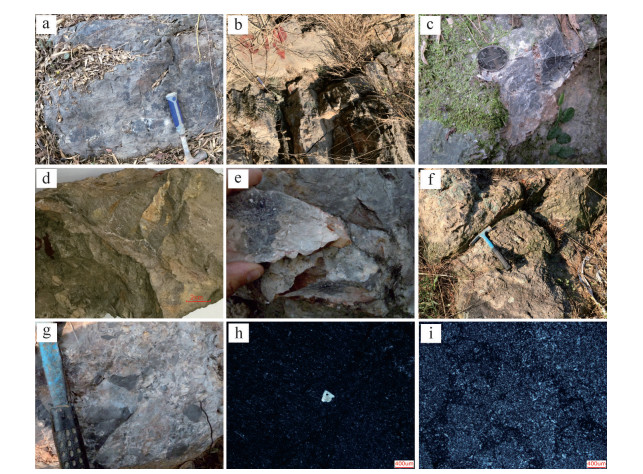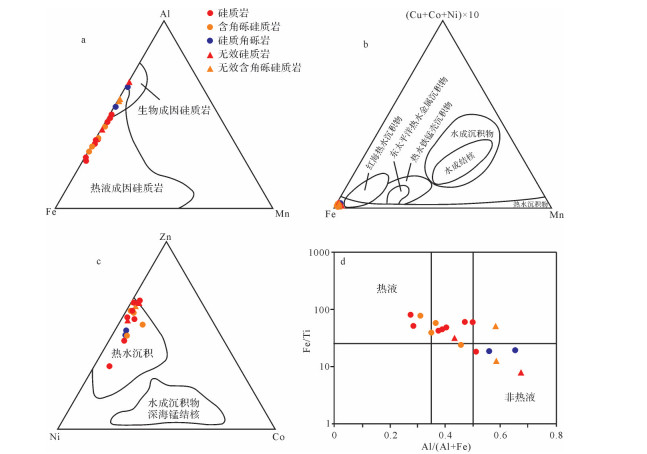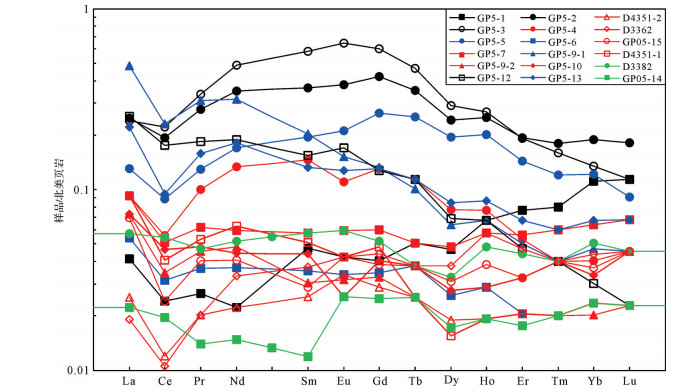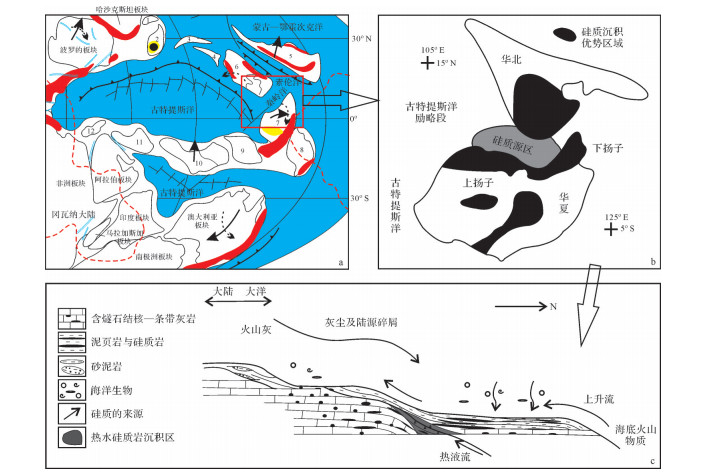HTML
-
热水沉积是指地球内部物质和能量释放到近地表至地表所发生的以沉积作用为主,包括复杂的结晶、交代、充填等作用及其形成物的总称。华南地区热水沉积主要发育于震旦系顶部、泥盆系和二叠系,厚一般为几十米,表现为硅质岩建造、硫化物建造、BIF建造、重晶石建造等[1-3],其携带大量的热能和丰富的成矿物质,为成矿提供了物质基础。
20世纪40年代,梁继涛[4]在安徽省宣城市水东地区发现一套大致沿孤峰组微切层断裂形成的构造角砾岩,命名为“嵇亭岭砾岩”。1:20万宣城幅、广德幅区域地质调查报告[5]中,“嵇亭岭砾岩”的范围有所扩大,认为其为栖霞组灰岩硅化而成,系构造产物,不是正常沉积岩,不能作为地层单位;但尖棱状角砾岩与压性断层的力学性质相矛盾。“嵇亭岭砾岩”的成因一直存在较大争议:黄德志等[6]和汤加富等[7]认为其为滑动构造的产物;1:25万宣城市幅区域地质调查报告[8]认为其为硅化破碎带的产物;骆学全等[9]认为是火山喷发成因,是一套次生石英岩化火山熔岩和火山碎屑熔岩;王存智等[10]认为其层位为孤峰组,为正常海水沉积成因,角砾岩的形成与江南断裂带有关,后期海底热液进行了叠加或改造。
笔者在从事安徽1:5万寒亭、宣城、周王和水东幅区域地质调查时,对“嵇亭岭砾岩”进行了系统的岩石学和沉积地球化学研究,探讨了其层位归属和成因机制,为区域构造演化提供基础地质资料。
-
研究区位于扬子板块北缘,江南造山带与沿江褶皱带交接部位,江南断裂带和周王断裂带交汇处(图 1a),南东侧主要出露晚古生代志留纪—中生代三叠纪地层,北西侧主要为宣城盆地中生代白垩纪—新生代古近纪地层。
研究区二叠系出露良好,地层接触关系清晰,化石丰富。栖霞期冈瓦纳大陆冰川的消融导致了晚古生代以来最大的一次海侵,整体呈台地相碳酸盐岩夹硅质岩沉积;茅口早期受东吴运动影响,在区域拉张作用下,同沉积断裂发育,发生沉降,水体加深,呈陆棚相硅质岩夹碳质泥岩、钙质泥岩沉积;茅口晚期—乐平早期岩相分异最为明显,发生抬升和隆起,大规模的海退,陆地面积扩大,海域缩小,呈三角洲相泥页岩、长石砂岩沉积;乐平晚期,伴随着又一次较大规模海侵,呈陆棚相硅质岩、硅质页岩、页岩沉积。
“嵇亭岭砾岩”主要分布于泾县蔡村—宣州区新田北—宁国水东北观音洞一线(图 1b,c),整体呈北东向展布,北东向与北西向断裂极其发育,常与周边层位呈断层接触,局部与孤峰组呈整合接触。岩石新鲜面以灰白、浅灰色为主,少量深灰、灰黑色,微晶结构为主,块状构造,偶见水平层理和腕足类化石,主要由微晶—隐晶质石英组成。局部呈角砾状构造,角砾分布不均匀,呈棱角状—次棱角状,粒径2~30 mm,大小不一,偶见细条带状构造,成分主要为硅质岩,基质主要为微晶—隐晶质石英和较多的黏土矿物。
-
“嵇亭岭砾岩”层位存在着较大的争议:作为一套非正常沉积岩,大部分学者认为其为构造成因,其层位存在着栖霞组和孤峰组之争[5, 8, 10]。笔者通过路线地质调查和剖面测量发现:“嵇亭岭砾岩”为厚层—块状,具有“灰岩”的外貌特征,偶见燧石结核(图 2a),表现为栖霞组本部灰岩段—顶部灰岩段“硅化”和“角砾岩化”特征;孤峰组薄层硅质岩与下伏“嵇亭岭砾岩”呈整合接触;栖霞组臭灰岩段和下硅质层段为正常灰岩和硅质岩;“嵇亭岭砾岩”呈北东向展布,断裂发育,栖霞组臭灰岩段、石炭系与三叠系均为正常灰岩沉积(如:“嵇亭岭砾岩”与黄龙组呈断层接触,“嵇亭岭砾岩”表现为“非正常灰岩”,黄龙组为正常生物碎屑灰岩);栖霞组本部灰岩段偶见正常沉积灰岩、含燧石结核灰岩;“嵇亭岭砾岩”内部见腕足类化石。因此,笔者根据区域地质背景、“嵇亭岭砾岩”的产出特征初步得出:“嵇亭岭砾岩”层位应为栖霞组本部灰岩段中上部—顶部灰岩段,而非孤峰组,时代为中二叠世祥播阶。
-
根据宁国市水东镇北后胡村剖面(GP5)测量和路线地质调查,针对“嵇亭岭砾岩”的岩石学特征及产出状态,将其分为3类:硅质岩、含角砾硅质岩、角砾硅质岩。
(1)硅质岩
岩石主要呈灰白、浅灰色(图 2b,c),少量呈深灰色,块状构造,部分仍可见栖霞组本部灰岩段燧石结核(图 2a)。镜下呈隐晶质—微晶结构,成分为泥微晶—隐晶质石英(> 99%)(图 2i),偶见石英脉,脉宽0.1 mm左右。电子探针(BSE)下显示成分以SiO2为主(浅灰色),含量大于99%,偶见磁铁矿(亮白色)。
岩石呈厚层—块状产出、不受构造影响且具相对稳定的层位,偶见层纹和条带状构造,矿物结构以隐晶质—微晶结构为主,少量细晶结构(图 2i),以上特征显示可能为离热液通道较远的正常沉积灰岩,经热液中硅质物质充填置换的结果[12]。
(2)含角砾硅质岩
岩石主要呈灰白、浅灰色(图 2d,e),少量呈深灰色,块状构造,镜下呈隐晶质—微晶结构,成分主要为隐晶质—微晶石英(> 99%)(图 2h)和石英脉与孔洞。角砾含量10%~25%,以次棱角状—棱角状为主,少量呈次圆状(有塑性变形),分选性差,大小悬殊,砾径从几毫米到几厘米,大部分呈厘米级,不易与硅质岩区分,呈定向或杂乱排列,可能存在搬运,但搬运距离不远。电子探针下显示成分以SiO2为主,含量大于99%,偶见磁铁矿。
岩石呈厚层—块状产出、不受构造影响且具相对稳定的层位,角砾含量不高,排列不具统一的力学方向,角砾为同沉积作用的产物,偶见塑性变形或滑塌流动变形,以上特征显示其可能为一套喷气—沉积角砾岩,可能为离热液通道相对较近的正常沉积灰岩受沉积和热液作用后灰质被硅质物质置换的结果[12]。
(3)硅质角砾岩
岩石以灰白、浅灰色为主,角砾状构造(图 2f,g),角砾含量60%~95%,砾径0.3~6 cm,局部达15~20 cm,棱角状—次棱角状,大小不一,混杂分布,砾石成分为硅质岩。部分呈破碎裂隙,角砾位移不大,似角砾状(可拼接),具有张性角砾特征。偶见纹层状—条带状,似流动构造。基质主要为微晶石英和黏土矿物。
角砾多呈棱角状—次棱角状,少量具一定的磨圆,位移不大,杂乱堆积,部分可拼接,可能为张性同生断裂与热液活动共同作用的结果,具有喷气—隐爆角砾岩—滑塌角砾岩特征,为热水沉积岩。即位于热液通道附近,喷气通道中或附近碳酸盐岩经热液中硅质物质充填置换的结果[12]。
综上所述:“嵇亭岭砾岩”的形成与热液活动关系密切,距离热液通道的远近决定其产出形态,距离越近角砾越发育。其成因为碳酸盐岩中钙质被热液中硅质矿物充填置换的结果,钙质沉积和硅质充填几乎同时发生,其热液来源可能与同生断裂提供通道具有较为密切的关系[12]。
2.1. 层位归属
2.2. 样品特征
-
本次研究对二叠系“嵇亭岭砾岩”样品进行遴选,尽量避开裂隙和石英脉,共选取18个新鲜样品(其中硅质岩10个,含角砾硅质岩6个,角砾岩2个)用切割机除去表层,粉碎至2 cm3左右的小块,仔细挑选1 ~ 2 cm3的样品碎屑,尽量避开裂隙,并用离子水进行3次振荡清洗后烘干。再利用鄂式破碎机一次性高效破碎至2 mm(10目)以下,使用来复缩分器,按“1/2 + 1/4 + 1/8 …”手工多次缩分出300 g已破碎的样品用以研磨,缩分出300 g,用无污染钵在振动研磨机上研磨至85 %以上达到75 μm(200目)。
广州澳实分析检测有限公司采用X荧光光谱仪(XRF)、电感耦合等离子体发射光谱仪(ICP-AES)和电感耦合等离子体质谱法(IPC-MS)分析全岩样品的主量元素、微量元素和稀土元素含量。样品主量元素检测下限为0.01%,微量元素检测下限为(0.5~10)×10-6,稀土元素检测下限为(0.01~0.5)×10-6,分析质量达到或优于国家标准,测试结果见表1, 2, 3。
-
沉积物中的地球化学元素特征主要受控于物源。硅质岩中硅的来源主要有硅质生物[13]、热液流体[14-15]和富硅的岩石碎屑(陆源碎屑、火山碎屑等)[16]。岩石本身地球化学元素的特征易受陆源碎屑的混染的掩盖,因此在样品的选择与前期处理过程中,避免和降低陆源碎屑物质的混染的影响才能更好地反映样品的地球化学特征。
研究区硅质岩不同程度受到构造的影响,部分影响较为强烈,表现为硅质角砾岩,可能意味着部分样品受到了外来陆源碎屑物质(黏土矿物)混染的影响,不能较好地反映古海洋的地球化学特征,在数据分析过程中应引起重视。利用Murray et al. [17]纯硅质岩的SiO2含量在91% ~ 99%,Si/Al值在80 ~1 000,对测试的18组数据进行了有效性分析,发现4组数据(GP05-1、GP05-2、GP05-3和GP05-12)可能受到黏土矿物混染影响,在解释过程中未引入该数据。
-
下扬子地区二叠纪硅质岩广泛分布于栖霞组、孤峰组和大隆组,主要呈层状、条带状或结核状产出,但其成因和硅质来源一直存在着争论?针对上述争议,拟通过全岩样品的主量、微量和稀土元素分析,判断研究区硅质岩硅质来源,到底为生物成因还是热液成因?
-
热泉沉积物具有高SiO2和低Al2O3、TiO2、MgO的特征[18-19]。硅质岩中,Fe和Mn主要来自于热液的化学元素,而Al和Ti来自于陆地的化学元素,纯热液成因和纯生物成因硅质岩的Al/(Al+Fe+Mn)值为0.01~ 0.6,并随着离热水中心的距离变大而升高,并有硅质岩成因的Al-Fe-Mn三角图解[16, 18]。热水沉积硅质岩(Fe+Mn)/Ti > 20[20],Fe-Mn-(Cu-Co-Ni)×10[21]、Zn-Ni-Co和Al/Al+Fe-Fe-Ti[22]图解也可以判别硅质岩的成因。
由表 1可见:硅质岩的SiO2含量特别高,含量为95.75%~98.48%,均值为97.56%;TiO2、Al2O3和MgO含量明显偏低,分别为 < 0.01%~0.02%、0.28%~0.83%(均值为0.60%)、0.02%~0.08%(均值为0.04%)。含角砾硅质岩的SiO2含量为95.53%~97.61%,均值为96.97%,TiO2、Al2O3和MgO含量相对偏低,分别为 < 0.01%~0.03%、0.57%~1.03%(均值为0.81%)、0.04%~0.08%(均值为0.06%)。硅质角砾岩的SiO2含量为96.93%~97.66%,均值为97.30%,TiO2、Al2O3和MgO含量偏低,分别为0.01%~0.02%,0.91%~1.07%和0.03%~0.07%。以上均显示具有典型的热水沉积硅质岩特征。
类型 样品编号 Al2O3 CaO TFe2O3 K2O MgO MnO Na2O P2O5 SiO2 SO3 TiO2 LoI Al/ Al+Fe+Mn K2O+Na2O Si/ Al Al2O3/ Al2O3+Fe2O3 硅质岩 GP5-2 2.75 0.08 1.01 0.32 0.11 0.01 0.01 0.09 94.05 0.02 0.13 1.17 0.67 0.33 30.15 0.73 GP5-3 1.71 0.09 1.76 0.08 0.15 0.01 < 0.01 0.13 95.05 0.01 0.05 0.96 0.42 0.09 49.00 0.49 GP5-4 0.80 0.05 0.60 0.12 0.04 < 0.01 0.01 0.04 97.63 0.02 0.02 0.51 0.50 0.13 107.57 0.57 GP5-7 0.83 0.11 1.70 0.02 0.06 < 0.01 0.01 0.03 95.75 0.01 0.02 0.78 0.27 0.03 101.69 0.33 GP5-9-2 0.28 0.06 0.61 0.02 0.02 < 0.01 < 0.01 < 0.01 98.48 0.01 < 0.01 0.24 0.25 0.03 310.03 0.31 GP5-10 0.64 0.10 0.90 0.03 0.07 < 0.01 < 0.01 0.01 97.03 0.01 0.01 0.66 0.35 0.04 133.64 0.42 GP5-15 0.45 0.07 0.57 0.01 0.03 0.01 < 0.01 < 0.01 98.80 < 0.01 < 0.01 0.30 0.37 0.02 193.53 0.44 D4351-1 0.58 0.17 0.47 0.03 0.08 < 0.01 < 0.01 0.01 97.48 0.01 < 0.01 0.62 0.48 0.04 148.15 0.55 D4351-2 0.61 0.06 0.78 0.04 0.02 < 0.01 0.01 0.01 97.13 0.01 0.01 0.48 0.37 0.05 140.36 0.44 D3362 0.62 0.13 0.54 0.07 0.03 0.01 < 0.01 0.01 98.18 0.01 < 0.01 0.39 0.46 0.08 139.59 0.53 均值 0.60 0.09 0.77 0.04 0.04 0.01 0.01 0.02 97.56 0.01 0.02 0.50 0.38 0.05 159.32 0.45 含角砾硅质岩 GP5-1 1.69 0.12 0.92 0.23 0.09 < 0.01 < 0.01 0.01 95.50 0.01 0.07 0.81 0.58 0.24 49.81 0.65 GP5-12 1.57 0.04 0.88 0.02 0.03 < 0.01 < 0.01 0.02 96.18 0.01 0.01 0.81 0.57 0.03 54.00 0.64 GP5-5 0.94 0.09 0.91 0.07 0.06 0.01 0.01 0.06 97.19 0.01 0.03 0.56 0.44 0.08 91.14 0.51 GP5-6 0.57 0.11 0.74 0.01 0.04 < 0.01 < 0.01 0.01 97.61 0.01 < 0.01 0.66 0.36 0.02 150.95 0.44 GP5-9-1 1.03 0.12 1.79 0.02 0.08 < 0.01 < 0.01 0.04 95.53 0.01 0.01 0.93 0.30 0.03 81.76 0.37 GP5-13 0.68 0.03 1.04 0.10 0.04 0.01 < 0.01 0.02 97.54 0.01 0.02 0.43 0.33 0.11 126.44 0.40 均值 0.81 0.09 1.12 0.05 0.06 0.01 0.01 0.03 96.97 0.01 0.02 0.65 0.36 0.06 112.57 0.43 角砾岩 GP5-14 1.07 0.12 0.43 0.04 0.07 0.01 0.01 0.01 97.66 0.02 0.01 0.67 0.65 0.05 80.45 0.71 D3382 0.91 0.09 0.58 0.10 0.03 0.01 < 0.01 < 0.01 96.93 0.02 0.02 0.58 0.54 0.11 93.89 0.61 均值 0.99 0.11 0.51 0.07 0.05 0.01 0.01 0.01 97.30 0.02 0.02 0.63 0.59 0.08 87.17 0.66 Table 1. Characteristics of the major elements (%) from the Permian "Jitingling breccia" siliceous rocks
硅质岩样品Al/(Al+Fe+Mn)值为0.30~0.50,均值为0.38;含角砾硅质岩样品Al/(Al+Fe+Mn)值为0.30~0.44,均值为0.36;大部分样品显示具有热水沉积特征(Al/(Al+Fe+Mn)值< 0.4)[18]。硅质角砾岩样品Al/(Al+Fe+Mn)值为0.54~0.65,显示为正常生物沉积,但角砾的发育使其易受陆源的干扰(Al和Fe),其结果的可信度值得商榷。
Al-Fe-Mn图解(图 3a)、Fe-Mn-(Cu-Co-Ni)×10图解(图 3b)、Zn-Ni-Co图解(图 3c)和Al/(Al+Fe)-Fe/Ti图解(图 3d)均显示主体为热液沉积。Al/(Al+Fe)-Fe/Ti(图 3d)图解显示硅质角砾岩和无效数据出现相反结果,与Al/(Al+Fe+Mn)值基本一致。
总之,“嵇亭岭砾岩”硅质岩和含角砾硅质岩符合热液成因硅质岩的特征;硅质角砾岩可能受到构造的影响,混入了陆源碎屑和黏土矿物,总体符合热液成因的规律,个别图解出现矛盾的结果。
-
热水沉积硅质岩常表现为较高的Ba、Ga和U等微量元素含量[3]。正常海水中Th元素富集,而海底热水中U元素富集,正常海水的沉积速率缓慢,沉积物能从海水中汲取较多的Th元素,造成大多数沉积岩的Th元素富集,U元素相对不富集,即U/Th < 1;而海底热水的沉积速率较快,沉积物不能从海水中汲取较多的Th元素,造成热水沉积物中Th元素贫乏,而相对富集U元素,即U/Th > 1[23]。正常海相沉积岩的Ba/Sr比值一般小于1[24];而现代海底热水沉积物的Ba/Sr比值大于1,且Ba/Sr比值的大小与沉积物受热水影响的程度呈正相关关系[25]。
由表 3可见:硅质岩样品的Ba元素含量为(12.8 ~160.5)×10-6,均值为43.41×10-6(若排除GP5-4,均值为26.69×10-6),远低于其克拉克值(441×10-6);Ga元素含量为(0.8~2.8)×10-6,均值为1.44×10-6,远低于其克拉克值(18×10-6);样品的U元素含量为(0.53~ 3.35)×10-6,大部分样品低于克拉克值(2.25×10-6)。硅质岩样品的U/Th比值为2.65~5.23,均值为4.06,为典型的热液沉积(U/Th > 1)。Ba/Sr比值为1.05~9.50,均值为3.78,也显示为热液沉积(Ba/Sr > 1)。
类型 样品编号 Ba Cr Ga Rb Sr Th U Zr U/Th Br/Sr 硅质岩 GP5-2 358 140 4.2 17.2 60.5 2.42 11.05 30 4.57 5.92 GP5-3 138 130 2.6 4.5 64.8 1.14 5.78 13 5.07 2.13 GP5-4 160.5 160 2.1 6.9 16.9 0.64 3.35 6 5.23 9.5 GP5-7 41.2 70 1.5 1.8 7.8 0.85 2.87 8 3.38 5.28 GP5-9-2 11.2 190 0.7 1.2 5.5 0.2 0.53 2 2.65 2.04 GP5-10 47.4 110 1.1 2.5 10.8 0.56 2.2 5 3.93 4.39 GP5-15 12.8 310 0.8 1.2 7.9 0.31 1.62 3 5.23 1.62 D4351-1 26.8 30 1.1 1.7 11.9 0.28 1.03 < 2 3.68 2.25 D4351-2 31.8 100 1.4 2.7 7.7 0.49 1.78 4 3.63 4.13 D3362 15.6 120 2.8 6.4 14.9 0.16 0.76 2 4.75 1.05 均值 43.41 136.25 1.44 3.05 10.43 0.44 1.77 4.29 4.06 3.78 含角砾硅质岩 GP5-1 38.4 80 2.5 12.9 12.7 1.87 5.38 17 2.88 3.02 GP5-12 36.8 160 1.7 2.1 20.7 0.39 5.01 4 12.85 1.78 GP5-5 308 180 1.3 4.8 32.9 0.77 8.07 9 10.48 9.36 GP5-6 23.5 50 1.1 1.2 8.6 0.48 2.09 4 4.35 2.73 GP5-9-1 31.3 50 1.3 1.8 18.4 1.24 1.76 6 1.42 1.7 GP5-13 47.4 250 1.7 5.3 20.2 0.5 2.02 6 4.04 2.35 均值 102.55 132.50 1.35 3.28 20.03 0.75 3.49 6.25 5.07 4.03 角砾岩 GP05-14 47.4 50 1 3.1 17.1 0.84 1.61 6 1.92 2.77 D3382 60.2 120 2.2 6.5 17.3 0.75 1.36 7 1.81 3.48 均值 53.8 85 1.6 4.8 17.2 0.8 1.49 6.5 1.87 3.13 Table 3. Characteristics of trace elements (×10-6) from the Permian "Jitingling breccia" siliceous rocks
含角砾硅质岩样品的Ba元素含量为(23.5~ 380.0)×10-6,均值为102.55×10-6(若排除GP5-5,均值为34.07×10-6),低于其克拉克值(441×10-6);Ga元素含量为(1.1~1.7)×10-6,均值为1.35×10-6,远低于其克拉克值(18×10-6);U元素含量为(1.76~8.07)×10-6,均值为3.49×10-6(若排除GP5-5,均值为1.96×10-6),大部分样品低于克拉克值(2.25×10-6)。含角砾硅质岩样品的U/Th比值为1.42~10.48,均值为5.07;Ba/Sr比值为1.70 ~9.36,均值为4.03;均显示为热液沉积。
硅质角砾岩样品的Ba元素含量为(47.4~60.2)×10-6,均值为53.80×10-6,低于其克拉克值(441×10-6);Ga元素含量为(1.0~2.2)×10-6,均值为1.60×10-6,均低于其克拉克值(18×10-6);U元素含量为(1.36~1.61)×10-6,均值为1.49×10-6,均低于克拉克值(2.25×10-6)。硅质角砾岩样品的U/Th比值为1.81~1.92,均值为1.87;Ba/Sr比值为2.77~3.48,均值为3.13;均显示为热液沉积。
总之,研究区各样品显示具有较高的Ba、Ga和U,相对贫乏Th,具有热水沉积的特点;U/ Th和Ba/ Sr值均显示为热液成因,故“嵇亭岭砾岩”硅质岩为热液成因硅质岩。
-
研究区“嵇亭岭砾岩”中的稀土元素含量及参数见表 2。其中,∑REE为稀土元素总量(不含Y),LREE为轻稀土元素总量,HREE为重稀土元素总量,LREE/ HREE为轻、重稀土元素比值,(La/ Yb)N(N代表北美页岩标准化数据[26])是稀土元素北美页岩标准化图解中分布曲线的斜率,δCe和δEu反映Ce和Eu相对其相邻元素的分馏程度(Ce=2(Ce / CeN)/(Sm / SmN +Gd / GdN) [27]。
类型 样品名 La Ce Pr Nd Sm Eu Gd Tb Dy Ho Er Tm Yb Lu Y ΣREE LREE HREE L/H LaN/YbN δEu δCe Y/Ho 硅质岩 GP5-2 7.8 12.9 2.2 9.5 2.15 0.45 2.19 0.28 1.41 0.26 0.66 0.09 0.56 0.08 7 40.53 35 5.53 6.33 1.35 0.91 0.68 26.92 GP5-3 7.6 14.8 2.66 13.2 3.42 0.76 3.13 0.37 1.69 0.28 0.65 0.08 0.4 0.05 7.1 49.09 42.44 6.65 6.38 1.84 1.02 0.71 25.36 GP5-4 2.9 3.7 0.79 3.6 0.86 0.13 0.68 0.09 0.45 0.08 0.18 0.02 0.12 0.02 1.9 13.62 11.98 1.64 7.3 2.34 0.74 0.53 23.75 GP5-7 2.9 3.4 0.49 1.6 0.34 0.07 0.31 0.04 0.28 0.06 0.19 0.03 0.19 0.03 1.6 9.93 8.8 1.13 7.79 1.48 0.95 0.61 26.67 GP5-9-2 2.3 2.3 0.36 1.3 0.18 0 0.17 0.02 0.1 0.02 0.06 0.01 0.06 0.01 0.4 6.89 6.44 0.45 14.31 3.71 1 0.54 20.00 GP5-10 2.3 3.1 0.38 1.2 0.26 0.03 0.21 0.03 0.16 0.03 0.11 0.02 0.1 0.02 0.9 7.95 7.27 0.68 10.69 2.23 0.56 0.71 30.00 GP05-15 2.2 1.6 0.32 1.1 0.17 0.05 0.2 0.03 0.18 0.04 0.11 0.02 0.11 0.02 1 6.15 5.44 0.71 7.66 1.94 1.18 0.4 25.00 D4351-1 2.9 2.7 0.42 1.7 0.3 0.05 0.25 0.02 0.09 0.02 0.07 0.01 0.07 0.01 0.6 8.61 8.07 0.54 14.94 4.01 0.8 0.51 30.00 D4351-2 0.8 0.8 0.16 0.6 0.15 0.04 0.15 0.02 0.11 0.02 0.06 0.01 0.06 0.01 0.5 2.99 2.55 0.44 5.8 1.29 1.17 0.48 25.00 D3362 0.6 0.7 0.16 0.9 0.22 0.05 0.23 0.03 0.22 0.06 0.16 0.02 0.13 0.02 2.1 3.5 2.63 0.87 3.02 0.45 0.97 0.49 35.00 均值 2.11 2.29 0.39 1.50 0.31 0.05 0.28 0.04 0.20 0.04 0.12 0.02 0.11 0.02 1.13 7.46 6.65 0.81 8.94 2.18 0.92 0.53 28.25 含角砾硅质岩 GP5-1 1.3 1.6 0.21 0.6 0.28 0.05 0.21 0.04 0.27 0.07 0.26 0.04 0.33 0.05 2.4 5.31 4.04 1.27 3.18 0.38 0.9 0.65 34.29 GP5-12 8 11.7 1.46 5.1 0.91 0.2 0.66 0.09 0.4 0.07 0.16 0.02 0.09 0.01 1.3 28.87 27.37 1.5 18.25 8.61 1.13 0.74 18.57 GP5-5 4.1 5.9 1.02 4.6 1.15 0.25 1.38 0.2 1.13 0.21 0.49 0.06 0.36 0.04 6.9 20.89 17.02 3.87 4.4 1.1 0.86 0.63 32.86 GP5-6 1.7 2.1 0.29 1 0.21 0.04 0.18 0.03 0.15 0.03 0.07 0.01 0.07 0.01 0.7 5.89 5.34 0.55 9.71 2.35 0.9 0.64 23.33 GP5-9-1 15.2 15.4 2.46 8.5 1.2 0.18 0.69 0.08 0.37 0.07 0.17 0.02 0.14 0.02 1.7 44.5 42.94 1.56 27.53 10.52 0.85 0.54 24.29 GP5-13 7 6.3 1.25 4.9 0.78 0.15 0.68 0.09 0.49 0.09 0.23 0.03 0.2 0.03 2.3 22.22 20.38 1.84 11.08 3.39 0.9 0.46 25.56 均值 7.00 7.43 1.26 4.75 0.84 0.16 0.73 0.10 0.54 0.10 0.24 0.03 0.19 0.03 2.90 23.38 21.42 1.96 13.18 4.34 0.88 0.57 29.00 角砾岩 GP05-14 0.7 1.3 0.11 0.4 0.07 0.03 0.13 0.02 0.10 0.02 0.06 0.01 0.07 0.01 0.5 3.03 2.61 0.42 6.21 0.97 1.30 0.99 25.00 D3382 1.8 3.6 0.37 1.4 0.34 0.07 0.27 0.03 0.19 0.05 0.15 0.02 0.15 0.02 1.4 8.46 7.58 0.88 8.61 1.16 1.01 0.96 28.00 均值 1.3 2.5 0.24 0.9 0.21 0.05 0.20 0.0 0.15 0.04 0.11 0.02 0.11 0.02 0.95 5.75 5.10 0.65 7.41 1.07 1.15 0.98 28.57 注:L/H:LREE/HREE。 Table 2. Characteristics of rare earth elements (REE, ppm) from the Permian "Jitingling breccia" siliceous rocks
(1) 稀土元素特征
硅质岩的稀土元素特征是判别其成因类型的重要标志,能较好的区分正常生物沉积与热水沉积[28]。已有的研究表明,热水沉积硅质岩的稀土元素总量(∑REE)偏低,铈元素呈负异常,而铕元素呈弱负异常或正异常,且重稀土元素(HREE)相对富集;而正常生物沉积硅质岩的稀土元素总量(∑REE)偏高,铈元素呈正异常,而重稀土元素(HREE)相对不富集[29]。典型热液沉积物常具有Eu正异常,明显的δEu异常出现的区域有限,仅在海底火山(热液)活动中心周围数十千米以内出现[14, 30]。δEu正异常仅仅出现于温度200 ℃以上的热液流体中[31],这说明温度是形成δEu异常的一个至关重要的因素。
由表 2可见:硅质岩样品的稀土总量(∑REE)总体偏低,为(2.99~13.62)×10-6,均值为7.45×10-6;δCe含量为0.40~0.71,均值为0.53,均具有明显的负异常;δEu含量为0.56~1.18,均值为0.92,异常不明显,部分呈弱负异常,部分呈弱正异常,具有热液成因硅质岩的特征,可能为热液的远端沉积。
含角砾硅质岩样品的稀土总量(∑REE)总体偏低,为(5.89 ~ 44.50)×10-6,均值为23.38×10-6;δCe含量为0.46 ~ 0.64,均值为0.57,均具有明显的δCe负异常;δEu含量为0.85~0.90,均值为0.88,呈弱负异常,具有热液成因硅质岩的特征,可能为热液的中远端沉积。
硅质角砾岩样品的稀土总量(∑REE)总体偏低,为(3.03~8.46)×10-6,均值为5.75×10-6;δCe含量为0.96~0.99,异常不明显;δEu含量为1.01~1.30,呈弱正异常。具有热液沉积岩特征,且位于近端,与角砾岩成因基本一致。
(2) Y/ Ho异常分析
Y和Ho具有相似的离子半径、化合价和地球化学行为,海水中Ho沉淀的速率高于Y两倍,Y/ Ho值可作为区别海相和非海相沉积的有用指标[32-33]。
研究区硅质岩的Y/ Ho值介于20.00~35.00,均值为26.93;含角砾硅质岩的Y/Ho值介于23.33~32.86,均值为26.51;硅质角砾岩的Y/Ho值介于25.00~28.00,均值为26.50;均接近上地壳的Y/Ho值(27.5)[34-35]和北美页岩的Y/Ho值(25.96)[26],远低于现代海水的Y/Ho值范围44~74的下限[36]。以上特征表明研究区硅质岩为非海水沉积,为异常沉积,与前文热液沉积基本一致。
(3) 稀土元素的北美页岩标准化配分模式
在沉积岩稀土元素(REE)地球化学研究中,常将样品测量值与北美页岩(NASA)样品中对应元素比值进行比较,热水沉积硅质岩经北美页岩标准化(NASC)后的稀土元素配分曲线呈平缓左倾谱型,而正常生物沉积硅质岩经北美页岩标准化(NASC)后的稀土元素配分曲线呈平缓右倾谱型[1, 37]。
研究区硅质岩(图 4红色)、含角砾硅质岩(图 4蓝色)和硅质角砾岩(图 4绿色)样品经北美页岩标准化(NASC)后的稀土元素配分曲线不明显;La-Eu段(除Ce外)轻稀土元素配分曲线表现为平缓的左倾谱型,说明轻稀土元素(除Ce外)之间的分馏程度一般;存在Ce的负异常;Gd-Lu段重稀土元素配分曲线整体较为平坦,大部分呈平缓的左倾谱型,部分呈右倾谱型,元素之间的分馏程度相对较高;大部分Ho呈现正异常。以上特征表明岩石具有热水沉积的特征。
3.1. 样品采集、处理与测试
3.2. 样品测定结果有效性分析
3.3. 硅质岩来源与成因机理
3.3.1. 主量元素特征
3.3.2. 微量元素特征
3.3.3. 稀土元素特征
-
由于全岩分析可能带入一些杂质,因此本文选择角砾岩中硅质部分(角砾和基质)进行了原位地球化学分析。矿物原位微量元素含量分析在合肥工业大学资源与环境工程学院矿床成因与勘查技术研究中心(OEDC)矿物微区分析实验室利用LA-ICP-MS完成(激光剥蚀系统为CetacAnalyte HE,ICP-MS为Agilent 7900)。对分析数据的离线处理(包括对样品和空白信号的选择、仪器ICPMSDataCal使用说明灵敏度漂移校正和元素含量采用软件ICPMSDataCal[38]完成。具体测试参数和分析流程参考[39-40],数据分析测试结果见表 4。
类型 Ba Sr Th U Ba/Sr U/Th 类型 Ba Sr Th U Ba/Sr U/Th 角砾 3.63 2.25 0.040 0.10 1.62 2.52 基质 2.43 1.73 0.29 0.100 1.40 0.34 4.35 3.35 0.0084 0.11 1.30 13.47 2.64 1.85 0.13 0.20 1.43 1.58 3.50 1.65 0.017 0.089 2.11 5.22 4.13 1.76 0.013 0.14 2.34 10.85 3.30 2.36 0.016 0.085 1.40 5.20 2.85 2.65 0.021 0.055 1.08 2.68 3.56 1.99 0.021 0.20 1.79 9.53 2.44 1.93 0.050 0.11 1.27 2.15 4.30 2.72 0.017 0.088 1.58 5.05 2.81 1.91 0.019 0.076 1.47 3.98 3.43 2.23 0.019 0.099 1.54 5.21 2.15 3.03 0.0063 0.34 0.71 53.55 3.04 1.87 0.063 0.40 1.63 6.28 2.26 1.85 0.18 0.12 1.22 0.70 4.27 2.00 0.011 0.091 2.13 8.17 3.03 2.01 0.081 0.17 1.51 2.13 4.87 1.63 0.026 0.14 2.98 5.34 2.61 3.81 0.078 0.14 0.68 1.79 5.24 1.91 0.024 0.096 2.75 4.00 3.32 4.25 0.012 0.087 0.78 7.45 6.02 2.21 0.060 0.10 2.72 1.72 3.22 1.67 0.031 0.28 1.93 9.12 4.12 1.76 0.022 0.12 2.35 5.56 2.40 1.94 0.049 0.24 1.23 4.98 7.90 2.55 0.17 0.17 3.10 1.03 3.50 1.48 1.29 0.095 2.36 0.07 5.03 2.03 0.018 0.12 2.48 6.59 3.89 2.17 0.042 0.13 1.79 3.03 均值 4.44 2.17 0.04 0.13 2.10 5.66 均值 2.91 2.27 0.15 0.15 1.41 6.96 Table 4. In situ geochemical (×10-6) characteristics for breccia and matrix
由表 4看出:角砾的Ba值为(3.04~7.90)×10-6,均值为4.44×10-6;Sr值为(1.63~3.55)×10-6,均值为2.17×10-6;Th值为(0.008 4~0.063)×10-6,均值为0.04×10-6;U值为(0.088~0.20)×10-6,均值为0.13×10-6;Ba/Sr比值为1.30~3.10,均值为2.10,显示为热液沉积(Ba/Sr > 1);U/Th比值为1.03~13.47,均值为5.66,也显示为热液沉积(U/Th > 1)。
基质的Ba值为(2.15~4.13)×10-6,均值为2.91×10-6;Sr值为(1.48~4.25)×10-6,均值为2.27×10-6;Th值为(0.012~0.29)×10-6,均值为0.15×10-6;U值为(0.055~0.28)×10-6,均值为0.15×10-6;Ba/Sr比值为0.71~2.36,均值为1.41;U/Th比值为0.34~53.55,均值为6.96;大部分呈热液沉积(Ba/Sr > 1),少量可能与陆源碎屑混入有关。
-
下扬子地区二叠纪普遍发育硅质岩,其成因机理与联合古陆西北缘硅质沉积事件不同,扬子地区二叠纪的硅质是由热源而并非冷源富集[41]。栖霞期至孤峰期期间的构造活动为以拉伸作用为主的大地构造背景[42],基底断裂和深大断裂的活化,并随之产生新断裂,激发深部岩浆房、火山活动及海底热水系统发育,为硅质岩的形成和保存提供了有利地形,又为热液活动提供了通道。研究区内发育江南断裂带、周王断裂带和旌德断裂,是否存在热水上升通道?
利用野外实测剖面和路线地质调查发现,用简单的构造成因来解释该套特殊的“嵇亭岭砾岩”存在较大的问题,其应为热液硅质充填置换碳酸盐岩形成,其岩石类型样式的不同可能与离热液通道的远近有较为密切的关系,越靠近热液通道,角砾越发育。
针对以上问题,利用岩石地球化学信息来诠释该套“嵇亭岭砾岩”的成因,通过全岩硅质岩元素图解、Al/(Al+Fe+Mn)比值、Ba/Sr、U/Th、δCe、δEu和稀土元素配分曲线均显示“嵇亭岭砾岩”为热液成因硅质岩。此外,“嵇亭岭砾岩”角砾和基质原位地球化学分析也显示为热液成因硅质岩。
据安徽省地质调查院[11]的研究表明,江南断裂带为同沉积断裂,形成时间较早,于寒武纪—奥陶纪已经存在,二叠纪存在活化的可能,在强烈的拉张运动下,可能形成了一系列地堑和地垒现象。如:各岩性分布范围和岩相古地理受同沉积断裂分割控制,二叠纪—三叠纪岩相古地理存在较多的跳相问题,相隔700 m殷坑组一边为台地相泥灰岩沉积,另一边为浅水陆棚相页岩、钙质页岩沉积。即中二叠世深部岩浆房上涌造成强烈的拉张断陷(图 5),形成了穹状隆起和一系列地堑与地垒构造,上涌的岩浆分布广泛,可能存在部分岩浆沿着地堑与地垒的断裂上涌,漫溢至海底乃至地表,上涌的岩浆与海水混合,使海水中硅质含量大幅度升高,发生一系列与热液相关的硅化作用和碳酸盐中硅的置换作用[43]。随着时间的推移,海水温度由高变低,SiO2溶解度的降低,大量SiO2从海水中析出,形成了热液成因的硅质岩;此外,深部岩浆房提供的热水中含有丰富的P、N、Fe、等生物营养元素和矿物质,随水体循环上升后能够引起海洋硅质生物繁盛,提高古生物产率,促进有机质供应,形成孤峰组生物成因的薄层硅质岩。

Figure 5. Middle Permian old land, dominant area distributions of siliceous deposits, and siliceous rock genesis pattern
总之,“嵇亭岭砾岩”发育于中二叠世栖霞组本部灰岩—顶部灰岩段,为异常的海相沉积,为热液成因硅质岩,为研究区二叠纪存在沿断裂分布的热水硅质岩提供了有利的证据。
-
(1) 安徽泾县—宣州地区中二叠统“嵇亭岭砾岩”为非构造成因,为异常沉积硅质岩,相当于栖霞组本部灰岩段中上部—顶部灰岩段,时代为中二叠世祥播阶。
(2) 安徽泾县—宣州地区中二叠统“嵇亭岭砾岩”的形成与热液活动有密切的关系,距离热液通道的远近决定其产出形态,可细分为硅质岩、含角砾硅质岩和硅质角砾岩,为热液中硅质矿物充填置换正常碳酸盐岩的结果,与同沉积断裂具有较为密切的关系。
(3) “嵇亭岭砾岩”全岩主量、稀土、微量元素、元素比值与元素图解和原位地球化学特征均显示具有典型热液成因硅质岩的特征。即中二叠世深部岩浆岩上涌造成强烈的拉张断陷,形成了穹状隆起和一系列地堑与地垒,可能存在部分上涌的岩浆沿着地堑与地垒的断裂上涌,漫溢至海底乃至地表,上涌的岩浆与海水混合,使海水中硅质含量大幅度升高,发生一系列与热液相关的硅化作用和碳酸盐中硅的置换作用。

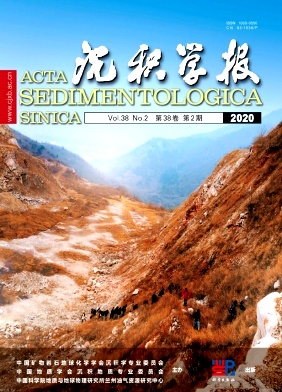


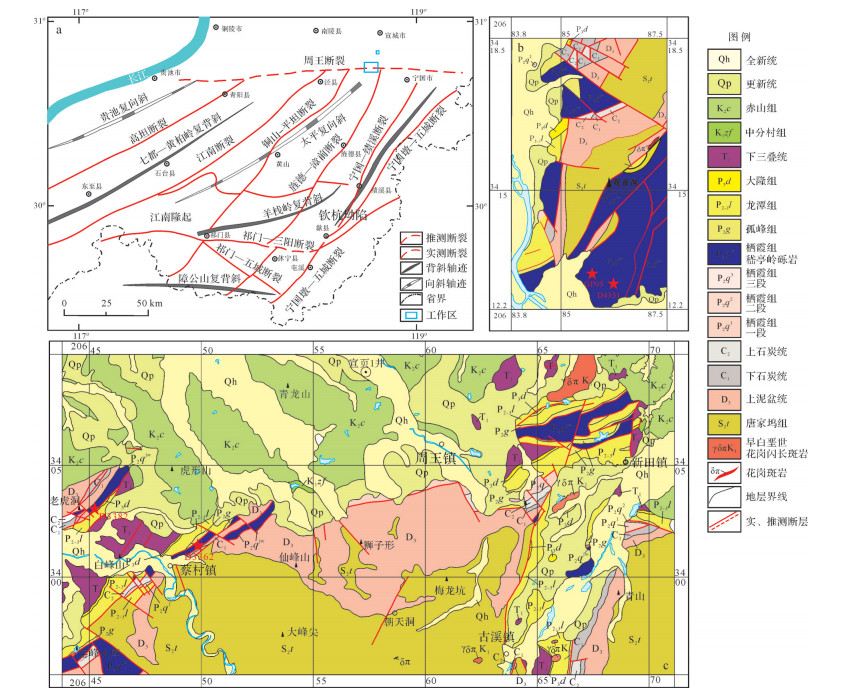






 DownLoad:
DownLoad:
